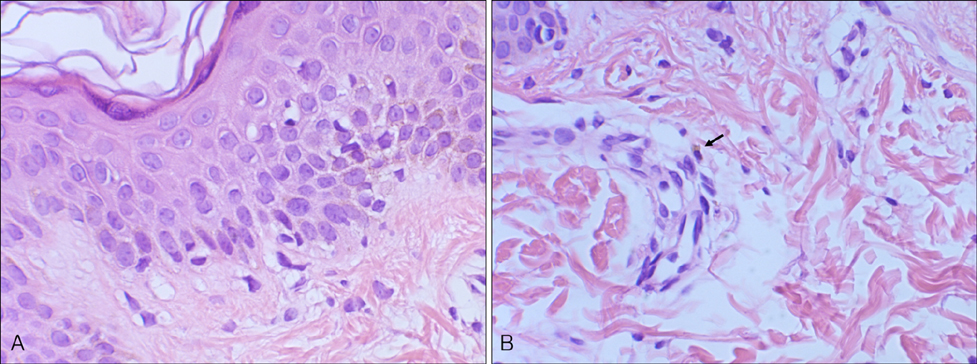Ann Dermatol.
2009 Feb;21(1):56-59. 10.5021/ad.2009.21.1.56.
A Case of Incontinentia Pigmenti Associated with Multiorgan Abnormalities
- Affiliations
-
- 1Department of Dermatology, University of Ulsan College of Medicine, Asan Medical Center, Seoul, Korea. 1052_hihi@hanmail.net
- KMID: 2172068
- DOI: http://doi.org/10.5021/ad.2009.21.1.56
Abstract
- Incontinentia pigmenti is a systemic disorder affecting the skin, teeth, eyes, nervous tissue, hair, nails, musculoskeletal system, and heart. We describe an 11-month-old girl with incontinentia pigmenti associated with a ventricular septal defect, left hemiatrophy, hemangiomas, an abnormal labial frenum, and spastic cerebral palsy manifested as left hemiplegia and developmental delay. We believe this patient illustrates that incontinentia pigmenti is a systemic disorder necessitating a multidisciplinary approach to management.
MeSH Terms
Figure
Reference
-
1. Bloch B. Eigentumliche, bisher nicht beschriebene pigment-affection (incontinentia pigmenti). Schweiz Med Wochenschr. 1926. 56:404–405.2. Sulzberger MB. Uber eine bisher nicht beschriebene congenitale pigmentanomalie (incontinentia pigmenti). Arch Dermatol Syphilol. 1928. 154:19–32.3. Cohen PR. Incontinentia pigmenti: clinicopathologic characteristics and differential diagnosis. Cutis. 1994. 54:161–166.4. Carney RG. Incontinentia pigmenti. A world statistical analysis. Arch Dermatol. 1976. 112:535–542.
Article5. Senturk N, Aydin F, Haciomeroglu P, Yildiz L, Totan M, Canturk T, et al. Pulmonary tuberculosis and cutaneous mycobacterial infection in a patient with incontinentia pigmenti. Pediatr Dermatol. 2004. 21:660–663.
Article6. Pacheco TR, Levy M, Collyer JC, de Parra NP, Parra CA, Garay M, et al. Incontinentia pigmenti in male patients. J Am Acad Dermatol. 2006. 55:251–255.
Article7. Berlin AL, Paller AS, Chan LS. Incontinentia pigmenti: a review and update on the molecular basis of pathophysiology. J Am Acad Dermatol. 2002. 47:169–187.
Article8. Fusco F, Bardaro T, Fimiani G, Mercadante V, Miano MG, Falco G, et al. Molecular analysis of the genetic defect in a large cohort of IP patients and identification of novel NEMO mutations interfering with NF-kappaB activation. Hum Mol Genet. 2004. 13:1763–1773.
Article9. Doffinger R, Smahi A, Bessia C, Geissmann F, Feinberg J, Durandy A, et al. X-linked anhidrotic ectodermal dysplasia with immunodeficiency is caused by impaired NF-kappaB signaling. Nat Genet. 2001. 27:277–285.
Article10. Jackson R. The lines of Blaschko: a review and reconsideration: Observations of the cause of certain unusual linear conditions of the skin. Br J Dermatol. 1976. 95:349–360.11. Ehrenreich M, Tarlow MM, Godlewska-Janusz E, Schwartz RA. Incontinentia pigmenti (Bloch-Sulzberger syndrome): a systemic disorder. Cutis. 2007. 79:355–362.12. Hadj-Rabia S, Froidevaux D, Bodak N, Hamel-Teillac D, Smahi A, Touil Y, et al. Clinical study of 40 cases of incontinentia pigmenti. Arch Dermatol. 2003. 139:1163–1170.
Article13. Vachvanichsanong P, Jinorose U, Sangnuachua P. Trisomy 14 mosaicism in a 5-year-old boy. Am J Med Genet. 1991. 40:80–83.
Article14. Yell JA, Walshe M, Desai SN. Incontinentia pigmenti associated with bilateral cleft lip and palate. Clin Exp Dermatol. 1991. 16:49–50.
Article






